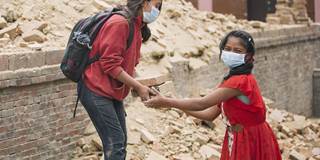The response to the earthquake is following a predictable pattern, with education taking a back seat to the immediate emergency response. A humanitarian fund for education in emergencies needs to be established, so that vulnerable children are not forced to wait in misery and insecurity while the adults pass around the begging bowl.
LONDON – A disaster happens. Bilateral aid is promised. Then the waiting game begins. It is a pattern that is all too common, and it is one that, sadly, is being repeated in Nepal. More than a week after the earthquake and aftershocks killed more than 7,000 people and devastated the capital, Kathmandu, and despite the mobilization of massive amounts of aid from international agencies, the country’s finance minister had yet to receive any of the money promised by foreign countries.

LONDON – A disaster happens. Bilateral aid is promised. Then the waiting game begins. It is a pattern that is all too common, and it is one that, sadly, is being repeated in Nepal. More than a week after the earthquake and aftershocks killed more than 7,000 people and devastated the capital, Kathmandu, and despite the mobilization of massive amounts of aid from international agencies, the country’s finance minister had yet to receive any of the money promised by foreign countries.